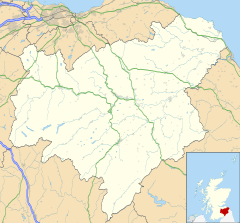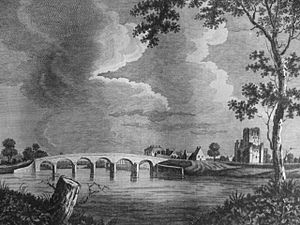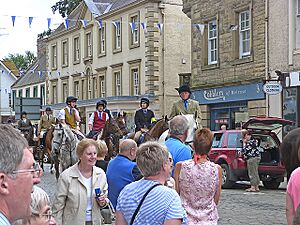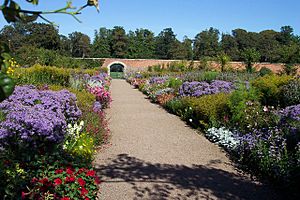Kelso, Scottish Borders facts for kids
Quick facts for kids Kelso |
|
|---|---|
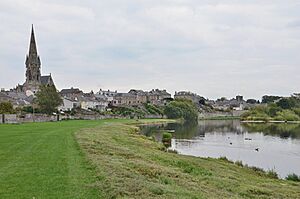 Kelso seen from the banks of the Tweed |
|
| Population | 6,870 (2020) |
| OS grid reference | NT7268233961 |
| • Edinburgh | 44 mi (71 km) |
| • London | 350 mi (560 km) |
| Council area | |
| Lieutenancy area |
|
| Country | Scotland |
| Sovereign state | United Kingdom |
| Post town | KELSO |
| Postcode district | TD5 |
| Dialling code | 01573 |
| Police | Lothian and Borders |
| Fire | Lothian and Borders |
| Ambulance | Scottish |
| EU Parliament | Scotland |
| UK Parliament |
|
| Scottish Parliament | |
Kelso is a lively market town located in the Scottish Borders region of Scotland. It sits right where two important rivers, the Tweed and the Teviot, meet. This historic town, once part of Roxburghshire, is home to about 5,600 people.
Kelso is a popular spot for visitors, thanks to its amazing ruined Kelso Abbey and the grand Floors Castle. Floors Castle was designed by a famous architect named William Adam and finished in 1726. The Kelso Bridge was built by John Rennie, who also designed the original London Bridge. Kelso once held the record for the coldest January temperature in the UK, reaching -26.7°C in 1881!
Contents
Discover Kelso's Past
Kelso began to grow because of Kelso Abbey, which was built in 1128. The town's name comes from an old word, "Calkou," meaning a chalky hill, which is remembered in a street name today, "Chalkheugh Terrace."
Kelso was once connected by a ferry to a royal town called Roxburgh, which was on the other side of the River Tweed. A small village existed before the abbey was finished, but it really started to thrive when the monks arrived. Many monks were skilled builders and craftspeople, and they helped the village grow.
Archaeologists found that the original medieval part of Kelso was further west than people thought. It was left empty in the 14th or 15th centuries, around the same time Roxburgh was also abandoned. This likely happened because the English army took over Roxburgh Castle. The other part of Kelso, near the abbey, continued to grow and became the Kelso we know today.
The abbey had a lot of control over the Kelso area until the Scottish Reformation in the 1500s. After that, the abbey lost its power and wealth. The Kerr family then took over much of the land and properties around the town. By the 1600s, they practically owned Kelso.
On Roxburgh Street, you can still see the outline of a horseshoe in the ground. It's said that Charles Edward Stuart (Bonnie Prince Charlie) lost a horseshoe there in 1745 while riding through town. He also supposedly planted a white rosebush in a garden, and its descendants are still found in the area.
For a while, Kelso was allowed to charge a small tax on every pint of ale or beer sold in town. This money was used to help pay for a new bridge across the River Tweed after a flood destroyed the old one.
Kelso Town Hall was finished in 1816 and updated in 1908. The Corn Exchange, which used to be a place for trading grain, was built in 1856. Today, it has health and dental clinics. The town's war memorial was put up in 1921 to honor those who served.
Life in Kelso Today
Kelso has schools for all ages. Kelso High School provides education for older students, while Edenside Primary and Broomlands Primary teach younger children.
The River Tweed in Kelso is famous for its salmon fishing. If you love golf, there are two 18-hole golf courses. The town also has a horse racing track, Kelso Racecourse, known as "Britain's Friendliest Racecourse." Horse racing has been happening in Kelso since 1822.
In 2005, Kelso hosted a big international event for fans of the Citroën 2CV car at nearby Floors Castle.
Kelso has a Community Council with 12 members who help run the town. The head of the council is called the Chairman and Town Provost.
Sports and Traditions
Kelso has its own rugby union club, Kelso RFC. The club hosts an annual rugby sevens tournament every May. Many famous rugby players have come from Kelso, including Ross Ford, who has played for the Scottish national team more than any other male player. Kelso RFC also has the oldest continuous rugby match between a Scottish and a Welsh team.
Every July, Kelso celebrates a border tradition called Kelso Civic Week. This festival lasts a whole week and is led by the "Kelsae Laddie" and his helpers. The Laddie and his followers ride horses to visit nearby villages. The main event is the Yetholm Ride on Saturday. Kelso also hosts an annual fair in early September with dancing, street performers, live music, and stalls. This fair brings about 10,000 people to the town!
Famous People from Kelso
Many interesting people have connections to Kelso. The famous writer Sir Walter Scott went to Kelso Grammar School in 1783. He once said that Kelso was "the most beautiful if not the most romantic village in Scotland."
You can enjoy the Cobby Riverside Walk, which goes from the town center to Floors Castle along the River Tweed. It passes the spot where the River Teviot joins the Tweed.
Kelso has two bridges over the River Tweed. "Rennie's Bridge" was finished in 1803. It replaced an older bridge that was destroyed by floods. This bridge was built by John Rennie, who later designed Waterloo Bridge in London. His Kelso bridge is a smaller, earlier version of the London bridge. In 1854, there were riots because people didn't want to pay tolls on the bridge anymore, even after it was paid for. The tolls were finally removed three years later. Hunter's Bridge, a newer bridge downstream, helps direct heavy traffic away from Rennie's Bridge to protect it.
Other famous people from Kelso include:
- Georgiana Solomon, a suffragette (someone who fought for women's right to vote), born in 1844.
- Sir James Brunlees, an engineer who built many railways and designed docks.
- Sir William Fairbairn, another engineer who built the first iron-hulled steamship and over 1,000 bridges using a new method.
- Thomas Pringle, a writer, poet, and abolitionist (someone who fought to end slavery).
- Donald Farmer, who received the Victoria Cross for bravery.
- Ross Ford, the record-holding rugby player mentioned earlier.
- Robert Allan Smith, a physicist.
- Jennie Kidd Trout, the first woman in Canada to practice medicine.
- James Thomson, a poet and composer.
Kelso in Film and Music
Part of the 1984 movie Greystoke: The Legend of Tarzan, Lord of the Apes was filmed at Floors Castle in Kelso. The castle was used as the fictional Greystoke Manor in the film.
Kelso is also mentioned in traditional folk songs, like 'The Shepherd Lad of Kelso' and 'The Old Woman of Kelso'.
Floors Castle: A Grand Home
Floors Castle is a very large and impressive home built in the 1720s, just outside Kelso. It's a popular place for visitors to explore. Near the castle, there's a big walled garden with a cafe and a small garden center.
Local Media
You can get local news and TV shows in Kelso from BBC Scotland and ITV Border. Local radio stations include BBC Radio Scotland and Greatest Hits Radio Scottish Borders and North Northumberland. The local newspapers are the Southern Reporter and Border Telegraph.
Twin Towns
Kelso has "twin town" friendships with two places in other countries:
 Kelso, in Washington, United States
Kelso, in Washington, United States Orchies, France
Orchies, France
Panorama
Weather Records
On July 19, 2022, Kelso set a new record for Scotland's hottest temperature at 35.1°C. This broke the previous record of 32.9°C set in Greycrook.
Images for kids
See also
 In Spanish: Kelso para niños
In Spanish: Kelso para niños


